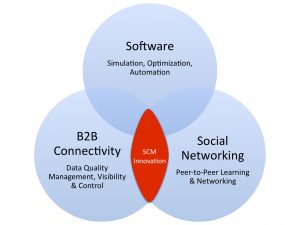What’s new in supply chain management? What’s going to drive the next wave of innovation?
As an industry analyst, I get those questions a lot from supply chain executives, as well as technology companies and third-party logistics providers (3PLs).
I always answer them with a question: Are you ready for innovation? Because as I’ve written before, you should forget about innovation if you can’t execute the small stuff.
But assuming you’ve mastered the basics, then another question comes up: How do you define supply chain innovation? According to research conducted by Dr. Jim Rice at MIT, not many supply chain innovations are truly revolutionary:
Most innovations in supply chain management build on existing achievements and reconfigure known methods and technologies rather than invent new ones. That doesn’t mean SCI is unexciting or largely irrelevant. On the contrary, incremental change represents one of the most powerful weapons companies have to stay ahead of the competition.
And, of course, some SCI’s do redefine markets. But in order to fully harness SCI, companies must distinguish between the steady and step-change varieties, and understand what it takes to implement them in terms of the organization’s strategic objectives. Inapt execution of an innovation can lead to costly missteps, particularly in today’s fast-paced competitive environment.
Are you ready for supply chain innovation? How do you define supply chain innovation? You have to answer those two questions first before embarking on your journey.
Here’s where I believe many companies will ultimately find opportunities for supply chain innovation: at the intersection of Software, B2B Connectivity, and Social Networking.

Software is what converts supply chain data into intelligence. It’s what allows companies to simulate supply chain scenarios, optimize networks, and automate processes.
But as I’ve argued before, software is not enough. You also need B2B connectivity — the ability to exchange (timely, accurate, and complete) data, documents, and other information with external business partners. And do so in a scalable, flexible, and cost-effective way. This is the foundation to enabling supply chain visibility and control. The best path forward, however, is not to build your own connectivity network, but to join existing communities of trading partners that are already connected to third-party B2B networks, which I call Supply Chain Operating Networks.
And finally, the next phase of Supply Chain Operating Networks is about facilitating communication and collaboration between supply chain and logistics professionals — the people side of supply chain management. And it’s about providing those professionals with network-based business intelligence and analytics to help them make smarter decisions faster. Simply put, Supply Chain Operating Networks are becoming the business equivalent of Facebook and LinkedIn, enabling communities of trading partners to communicate, collaborate, and execute business processes in more efficient, scalable, and innovative ways.
I will explore this topic in more detail at Elemica’s reveal 2014 Conference (May 6-7 in Philadelphia, PA) where I’m giving a keynote presentation titled, “Supply Chain Operating Networks: Communicate, Collaborate, Innovate.” If you’re a supply chain or logistics executive in the process industries, I encourage you to attend the conference and participate in the conversation. I will share my takeaways from the conference in a future post.
In the meantime, post a comment and share your perspective. Where will you find supply chain innovation?
(For related commentary, see The Rise of Supply Chain Operating Networks, A Pulse on Social Networking for Supply Chain Management, and Facebook Graph Search, Through a Supply Chain Lens).
Note: Elemica is a Talking Logistics sponsor.










